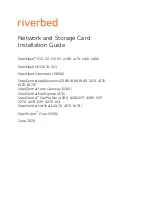
Detailed Installation
22
7) Connect SCSI Devices to the Storage Adapter
Use SCSI cables to connect SCSI devices to the SRCU42X controller.
To connect the SCSI devices:
a.
Disable termination on any SCSI device that does not sit at the end of the SCSI bus.
b.
Configure all SCSI devices to supply TERMPWR.
c.
Connect cables to the SCSI devices. The maximum cable length for Fast SCSI (10
Mbytes/s) devices or SE is 3 meters; it is 1.5 meters for Ultra SCSI devices; it is
12 meters for LVD devices. You can connect up to 15 Ultra SCSI devices to each
SCSI channel.
System throughput problems can occur if SCSI cables are not the correct type. To
minimize the potential for problems:
–
Use cables no longer than 12 meters for Ultra160 and Ultra320 devices.
–
For SE SCSI devices, use the shortest SCSI cables (no longer than 3 meters
for Fast SCSI, no longer than 1.5 meters for an 8-drive Ultra SCSI system,
and no longer than 3 meters for a 6-drive Ultra SCSI system).
–
Use active termination.
–
Avoid clustering the cable nodes.
–
The cable stub length must be no greater than 0.1 meter (4 inches.)
–
Use high impedance cables.
–
Route SCSI cables carefully.
8) Set SCSI Termination
The SCSI bus is an electrical transmission line and must be terminated properly to
minimize reflections and losses. Set termination at each end of the SCSI cable(s).
For a disk array, set SCSI bus termination so that removing or adding a SCSI device does
not disturb termination. An easy way to do this is to connect the SRCU42X controller to
one end of the SCSI cable and to connect an external terminator module at the other end
of the cable. You can then connect SCSI disk drives to the connectors between the two
ends of the cable. If necessary, disable termination on the SCSI devices. (This is not
necessary for Ultra320 and Ultra160 SCSI drives.)
Set the termination so that SCSI termination and TermPWR are intact when any disk
drive is removed from a SCSI channel, as shown in Figure 2.3.











































